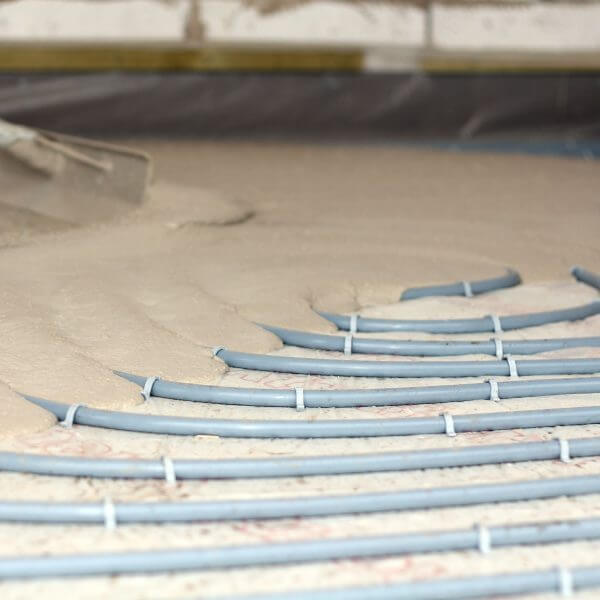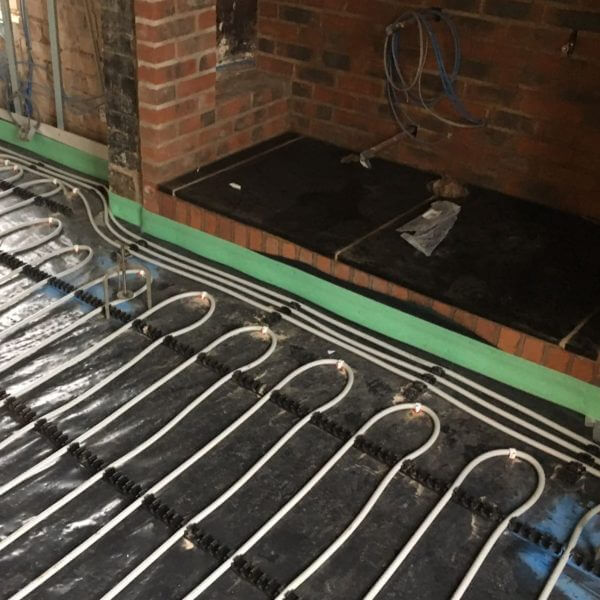Common Underfloor Heating Problems; The Complete Guide
Underfloor heating installations are high quality, robust, and long-lasting compared to radiators, but problems can occur. Understand what causes the most common underfloor heating problems, and what you can do to avoid them.
Some of these issues you can try to fix yourself if you feel confident to do so, but understand you may have complications if you have not been instructed in the correct procedure. If you are ever unsure, contacting an underfloor heating professional is recommended.
What Causes Problems in Underfloor Heating?
Poor design and poor installation quality are the primary reasons that many of the issues outlined here develop in a short timeframe. Of course, some faults occur naturally across the lifespan of the system, and this can be prevented through good maintenance and annual checkups. With EasyFlow, your installation has a 2-year workmanship guarantee, and we will cover you if any faults occur within that time. If you had another provider install your heating, be sure to have any records of a warranty or guarantee on hand.
One of the benefits of underfloor heating is that the majority of issues are localised to the manifold, heat source, or thermostat. It makes searching for issues much easier. Furthermore, the process of prevention through good maintenance is simplified.
The Floor Isn’t Heating
How underfloor heating works on a technical level is that a thermostat sends a signal to the manifold when a room drops below the desired temperature. The manifold then sends a signal to the heat source, the circulation pump, and the actuator. These all activate to begin the flow of hot water into the sytem. A problem with any one of these components can affect the distribution of heating across your home.
If you notice the floor isn’t heating up when it should, you first need to diagnose if it is a single zone that is affected, multiple zones, or all zones. If multiple zones are impacted, are they controlled by a single thermostat? From there, we can begin diagnosing the potential causes.
A Single Zone Isn’t Heating Up
If one zone is not heating, but all others are, this is most likely to be an issue with the thermostat not sending a signal to the manifold. It can also be an issue with an air bubble, or the actuator, preventing water from getting into the zone. The following procedure will help you narrow down the issue.
- Isolate your underfloor heating installation to the faulty zone alone. If the heat source is still running, this is indicative of a failed/faulty actuator or an air bubble blocking the system.
- You can bleed the system of air by turning the bleed valves or running an air purge program on your heat source.
- Check the pin valve near the actuator. If it is stuck, use nose pliers to free it.
- If the heat source is not running, check your thermostat for any error messages, change the battery if it is low, or reset it according to your user manual.
- If you receive an error code, follow the troubleshooting instructions in the thermostat manual and seek help from the manufacturer if necessary.
- If you are still experiencing problems, check with a professional experienced in underfloor heating thermostats and wiring boards.
Multiple Zones Are Not Heating Up
Multiple zones will use multiple thermostats, and a problem with multiple zones at once is most likely a blockage or the failure of a component on the manifold. It can still be a thermostat issue in rare circumstances.
- Isolate your underfloor heating to run only on the faulty zones. If the heat source is still running, there is an air blockage or an actuator issue.
- Refer to the instructions in the previous section on methods to clear an air bubble or actuator issue.
- If the heating stops running, check all your thermostats for any error messages.
- Change the battery if it is low, or reset it according to your user manual.
- If you are still experiencing problems, check with a professional experienced in underfloor heating thermostats and wiring boards.
All Zones Are Not Heating Up
If you have multiple zones controlled with multiple thermostats, and all are not heating, this can be indicative of an airlock in a pipe section before the manifold, an issue with the heat source, or the failure of a manifold component. The following procedures will help you narrow down the issue, but the majority of these will need an experienced underfloor heating engineer to fix.
- Check if the heat source is running and the system has adequate pressure.
- Refer to the water pressure issues section below if the pressure is not normal.
- If the heat source is not firing, there may be a problem with the manifold wiring connections or the power supply.
- Check if the main isolating switch supply is turned on.
- If off, there is no power being supplied to the wiring board.
- Check if you can hear a whirring noise from the circulation pump.
- If you cannot hear a noise, a mechanical or electrical fault is causing it to fail.
- Let air escape through your system’s bleed valves and run an air purge cycle on your heat source if you know how to do so.
- If it is none of the above, it may be the fault of another manifold component.
My Problem Happened Because of an Airlock. Are Underfloor Heating Setups Supposed to be Airtight? Do I have a Leak?
Heating systems naturally take in a very small amount of air and lower in pressure slowly over time. The older the components, the more likely this is to happen. An air vent placed at the highest point of the manifold helps remove air when it does get into the system. If this is a recurring issue, ask your heating engineer to instruct you on the correct air purge procedure with your heat source. This will help remove air bubbles between the heat source and the manifold.
Air likes to settle at the highest parts of the network, and you typically see large airlocks in points of elevation (e.g. piping going upwards, over the heat source and into the ceiling). A poorly designed system may not have anything in place to help the air escape from these problem areas.
The Floor Isn’t Reaching the Desired Temperature
If your floor feels a little colder than it normally does when the heating is on, this isn’t always a cause for concern. Your thermostats will communicate with the heat source, indicating what the flow temperature (the temperature of water running through the heating pipes) should be. If the floor only requires a little warming, the manifold may request a lower flow temperature for efficiency’s sake. Of course, there can be other causes, and the following procedure can help you diagnose this.
- Check the flow temperature reading on the heat source, then on the manifold. The manifold should read a temperature similar to, if not a few degrees lower than what the boiler reads when accounting for heat loss.
- If there is a dramatic difference, or the manifold shows a higher temperature than the boiler, there may be a problem with one or both of the temperature sensors or another component.
- Check the heat source’s water pressure when it is idle and when the heating is running.
- If the pressure is low you may need introduce more water into the system and bleed any air trapped in the system. Refer to the water pressure issues section below.
Water Pressure Issues
Pressure slowly decreases over time naturally as air is let into the system, and increases when the heating is on. The most common causes of pressure issues is from air bubbles trapped in the system, contaminated water, or faulty heat source components. Rapid loss in pressure is indicative of a significant leak, which would most likely be in the pipes that are not submerged in the floor. If you have an underfloor heating installation that does not run in continuous loops, then you may have joints or breaks elsewhere in the heating system, letting air in and water out.
Pressure is Too Low
- Check for leaks around the metal pipework, bleed valves, air vents, and boiler blow-off valve.
- If you still cannot detect the leak, repressurise the system, then isolate the manifold.
- If pressure drops on the boiler side, it is a leak in that part of the network.
- If pressure drops on the manifold side, it is a leak in the pipe network.
Pressure is Too High
- Check that the heat source’s water filling loop is sufficiently closed and not pushing more water into the system.
- If this is the case, close the filling loop and let water out of the drain-off point until pressure is at a safe level.
- Carry out pressure testing if you are confident and experienced to do so.
- If the pressure fluctuates, this could be a faulty pressure sensor in the boiler, dirty water, or air bubbles present in the system.
- If pressure stays high, it may be a fault in the expansion vessel or another heat source component.
- Depress the needle in the valve of the expansion vessel to check its integrity if you are confident to do so.
- If water comes out, the vessel has failed and requires replacement.
How to Find a Leak in Underfloor Heating Pipes
The most common cause for an underfloor heating leak is external damage to the pipes, such as from an impact or a puncture. A subtle leak will most likely lead to discoloured, damp patches in your Gyvlon screed or levelling compound, though this may not be easy to spot if the leak is small. A moisture detection metre or thermal imaging camera can find the exact source of the leak. With the leak site identified, you can carry out repairs with minimal disruption to your flooring.




Where To Find Us